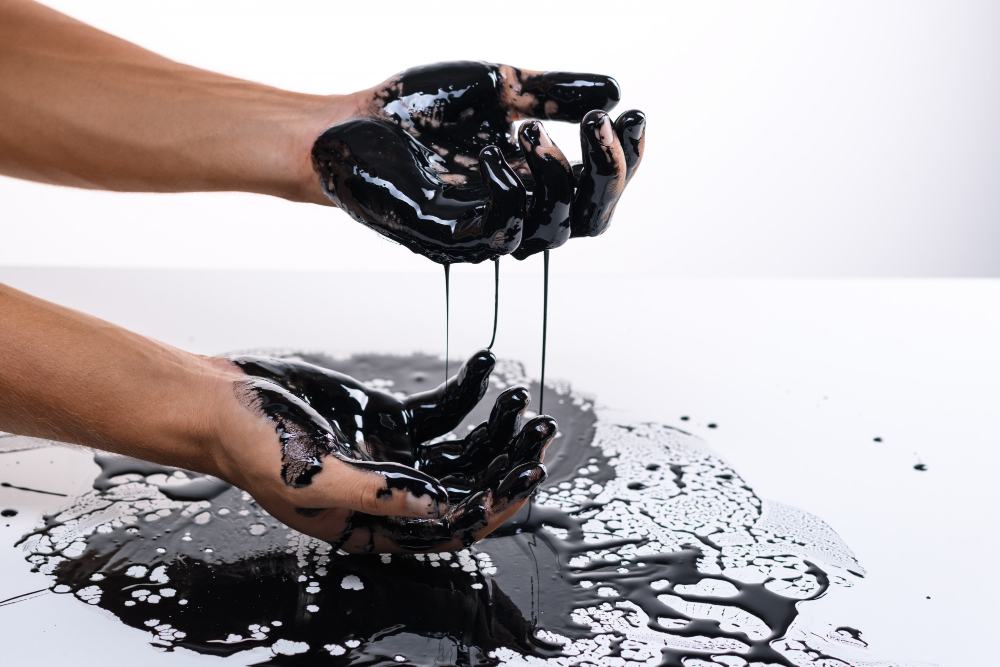Bitumen is not used as a fuel because it is too thick, heavy, and non-volatile to burn efficiently. It has a low combustion efficiency, high sulphur and metal content, and produces excessive smoke and toxic gases when burned. Unlike petrol or diesel, bitumen does not vaporise easily and provides low energy output, making it unsuitable for engines or boilers. Instead, it is primarily used in road construction and waterproofing due to its strong adhesive and durable properties.
Bitumen, often recognised for its sticky, tar-like texture and deep black colour, plays a significant role in modern infrastructure, especially in road construction and waterproofing applications. However, despite being a petroleum-derived product, bitumen is not used as a fuel. Many people wonder why a material obtained from crude oil, which produces energy-rich fuels like petrol and diesel, cannot itself be burned as an energy source.
The answer lies in its chemical composition, physical characteristics, and environmental implications. This detailed guide explains why bitumen isn’t suitable for fuel use, how it differs from other petroleum products, and why industries prefer to use it in non-combustive applications.
What Is Bitumen?
Bitumen is the heaviest fraction obtained during the refining of crude oil. It’s a viscous, black, semi-solid form of petroleum that remains after lighter components, such as petrol, kerosene, and diesel, have been distilled off.
In simple terms, it’s the residue left at the bottom of the fractionating column after all other hydrocarbons have been separated. It’s so dense that even at high temperatures, it doesn’t easily vaporise. Because of this, it cannot undergo the same combustion process as lighter fuels.
Bitumen is composed of large, complex hydrocarbon molecules, typically containing carbon, hydrogen, sulphur, oxygen, nitrogen, and traces of metals like vanadium and nickel. These molecular structures are extremely stable and resistant to burning, which makes bitumen more useful for construction than for energy production.
How Bitumen Is Produced
During crude oil refining, the oil is heated to a temperature of around 350°C to 400°C and separated into various fractions based on their boiling points. The lighter fractions, such as gases and petrol, rise to the top of the distillation column, while heavier ones like diesel and lubricating oils settle lower down.
The heaviest fraction, bitumen, remains at the bottom because it does not vaporise even at these high temperatures. Sometimes, refineries subject this residue to further processing (like vacuum distillation) to remove slightly lighter oils, leaving behind pure bitumen.
This leftover material is too heavy and dense to be used as a fuel. Instead, it’s waterproofing, adhesive, and binding properties make it ideal for road surfacing and industrial applications.
Why Bitumen Is Not Used as a Fuel
There are several scientific, economic, and environmental reasons why bitumen is unsuitable as a fuel. Let’s explore these factors in detail.
High Viscosity and Low Volatility
One of the primary reasons bitumen isn’t used as a fuel is its thick, viscous nature. Unlike petrol or diesel, which flow easily and vaporise quickly for combustion, bitumen is semi-solid at room temperature.
For efficient combustion, a fuel must vaporise easily so it can mix with air and burn completely. Bitumen, however, requires extremely high temperatures to even begin vaporising, and even then, the process is incomplete. This makes it impractical for regular engines or boilers.
In essence, bitumen is too thick to burn efficiently, resulting in incomplete combustion and excessive smoke or residue.
Low Combustion Efficiency
When bitumen is heated, it doesn’t burn cleanly. Instead, it produces thick black smoke, soot, and toxic gases such as sulphur dioxide and carbon monoxide.
Efficient fuels like petrol and diesel burn with a clean, blue flame, producing mostly carbon dioxide and water vapour. Bitumen, on the other hand, has a very low hydrogen-to-carbon ratio, meaning it contains far more carbon than hydrogen. This imbalance leads to poor combustion and reduced energy output.
Moreover, the high content of heavy metals in bitumen contributes to high ash formation, which clogs burners and damages equipment.
High Sulphur and Metal Content
Bitumen contains significant amounts of sulphur compounds and trace metals such as nickel, iron, and vanadium. When burned, these substances release pollutants that can damage the environment and corrode combustion systems.
The resulting emissions would not only violate environmental regulations but also lead to health hazards. Sulphur dioxide, for example, contributes to acid rain, while heavy metals can contaminate soil and water.

Low Calorific Value Compared to Fuels
The calorific value of a substance measures how much energy it releases during combustion. Bitumen has a significantly lower calorific value than lighter fuels due to its dense molecular structure.
While petrol or diesel provides a high energy output per kilogram, bitumen yields less heat for the same quantity. Therefore, using it as a fuel would be inefficient and uneconomical.
Environmental Concerns
The environmental impact of burning bitumen would be severe. The thick smoke, carbon emissions, and toxic by-products would make it one of the dirtiest fuels imaginable.
In today’s world, where there’s a strong emphasis on reducing carbon emissions and promoting clean energy, burning bitumen would go completely against sustainable practices.
Instead, bitumen is used responsibly in industries such as construction, where it poses minimal environmental risks when handled correctly.
Better Economic Value in Construction
From a commercial perspective, bitumen holds far greater value in construction than as a source of energy. It is the primary material used in road surfacing, roofing, and waterproofing because of its adhesive and flexible nature.
Each year, millions of tonnes of bitumen are used globally to pave roads and motorways, forming the backbone of transport infrastructure. Using it as fuel would not only be wasteful but also remove a crucial material from the construction industry.
Technological Limitations
Most combustion systems, from car engines to power plants, are designed to operate on liquid or gaseous fuels. Bitumen’s semi-solid state makes it difficult to handle, transport, and feed into burners.
To use it as a fuel, bitumen would need to be pre-heated, mixed, and maintained at a high temperature, all of which require extra energy and specialised equipment. The cost of these modifications would far outweigh the benefits of using it as fuel.
How Bitumen Differs from Other Fuels
Property | Petrol | Diesel | Bitumen |
State at room temperature | Liquid | Liquid | Semi-solid |
Volatility | High | Moderate | Very low |
Combustion | Clean and efficient | Moderate | Smoky and incomplete |
Calorific value (MJ/kg) | ~44 | ~42 | ~30 |
Sulphur content | Low | Moderate | High |
Use | Fuel | Fuel | Construction |
This comparison clearly shows why bitumen does not function well as a fuel source. Its composition and characteristics make it suitable for entirely different purposes.
Common Uses of Bitumen
Even though bitumen cannot be used as a fuel, it plays an essential role in several industries:
- Road Construction: Bitumen binds aggregates together to form asphalt, creating smooth, durable road surfaces.
- Roofing and Waterproofing: Its impermeability to water makes it ideal for protecting buildings and foundations.
- Insulation: Bitumen provides excellent soundproofing and heat insulation in industrial and residential buildings.
- Sealing and Coating: Used to seal leaks, cracks, and protect metal structures from corrosion.
- Industrial Applications: Serves as a raw material in producing adhesives, paints, and protective coatings.
These uses make bitumen far more valuable as a construction and sealing material than as an energy source.
Could Bitumen Ever Be Used as a Fuel?
In theory, yes, but only after extensive processing. Bitumen can be upgraded into lighter synthetic crude oil through processes such as catalytic cracking or hydrocracking, which break down heavy hydrocarbons into smaller, more combustible molecules.
However, these processes are expensive, energy-intensive, and environmentally challenging. Therefore, direct use of bitumen as a fuel remains impractical.
Some power plants in the past experimented with burning bitumen or bitumen-based fuels, but due to low efficiency and high emissions, such methods were quickly abandoned.
Environmental and Economic Perspective
From an environmental standpoint, avoiding the use of bitumen as fuel helps reduce air pollution and toxic waste. Economically, it ensures the availability of an essential material for the construction and maintenance of roads and infrastructure, which is vital for global development.
In a world that is rapidly shifting towards renewable energy and sustainability, conserving bitumen for infrastructure rather than burning it as fuel aligns better with eco-friendly objectives.
Final Thoughts
So, why is bitumen not used as a fuel? The answer lies in its physical state, low volatility, high sulphur and metal content, poor combustion efficiency, and environmental risks. While it originates from crude oil, its properties make it unsuitable for energy production.
Instead, bitumen’s exceptional binding and waterproofing qualities make it indispensable in road construction, roofing, and industrial sealing. Using it for these purposes not only maximises its value but also prevents the harmful environmental impact of burning it.
In the UK, 123 Oil continue to highlight the importance of efficient fuel use and responsible energy practices. Understanding why substances like bitumen are better suited for construction than combustion helps promote smarter, more sustainable energy consumption.
Ultimately, bitumen is a perfect example of how not every petroleum derivative is meant to burn, some are far more valuable when they build, protect, and strengthen the world around us.
Frequently Asked Questions
Bitumen cannot be used as a fuel because it is too thick and viscous to burn efficiently. It does not vaporise easily, leading to incomplete combustion and excessive smoke or soot.
When bitumen is burned, it produces black smoke, toxic gases, and heavy residues due to its high sulphur and metal content. This makes it both inefficient and harmful to the environment.
Bitumen is not highly flammable. It has a high ignition point, meaning it requires extremely high temperatures to start burning, making it unsuitable for use as a common fuel.
Yes, but only through complex refining processes, such as catalytic cracking or hydrocracking. These processes are expensive and energy-intensive, so they’re rarely used for fuel production.
Bitumen is highly adhesive, waterproof, and durable, making it perfect for road surfacing, roofing, and sealing applications. Its physical properties offer more economic and practical value in construction than as an energy source.










